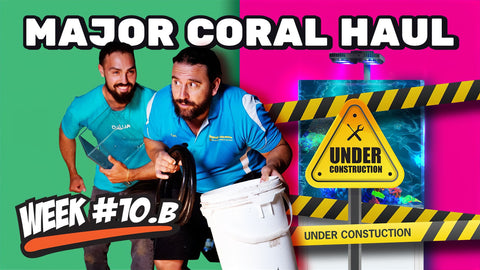Starting A Reef Tank | 12 Week Reef Video Tutorial #1
Starting a Reef Tank: Unboxing Your First Aquarium and Key Differences from Freshwater Tanks
Today, you’ll be unboxing your brand-new CADE aquarium, and if you’re thinking of starting a reef tank, you’ve come to the right place. Join this 12-week journey as you explore the ins and outs of creating a thriving reef tank, learning everything along the way.
Whether you’re transitioning from freshwater aquariums or starting from scratch, this guide will help you understand the key differences between freshwater and saltwater tanks while walking you through the unboxing and setup of your very first reef tank!
Unboxing Your First Reef Tank: Let the Journey Begin
The moment is here—your brand-new reef tank has arrived! The excitement (and slight nervousness) is real as you prepare to take this big step into reefing.
So, whether you’re a freshwater expert or brand new to aquariums, reef tanks can be a bit daunting. But trust me, you're going to tackle this together, with plenty of expert help along the way. This blog will serve as your go-to resource for how to start a reef tank from scratch.
Freshwater vs. Saltwater Tanks: What’s the Difference?
Before you jump into unboxing the tank, let’s talk about the key differences between freshwater and saltwater aquariums. These two types of aquariums share some similarities but have a few important distinctions:
What’s the Same?
- The Nitrogen Cycle: Just like in freshwater tanks, reef tanks require an established nitrogen cycle. This means zero ammonia (NH3), nitrites (NO2), and monitoring nitrates (NO3) to maintain water quality.
- pH Monitoring: Both types of tanks require regular pH testing to ensure water chemistry is within the proper range.
- Temperature Control: Maintaining a consistent temperature is crucial for both freshwater and reef tanks. Most reef tanks should be kept between 76-80°F (24-27°C).
What’s Different?
- Saltwater, of course! Unlike freshwater setups, reef tanks use saltwater to mimic the ocean’s conditions.
- Equipment Needs: Reef tanks often require additional equipment such as protein skimmers, led lighting, and more robust filtration systems to maintain the delicate balance of the marine environment.
- Water Parameters: In addition to pH and temperature, reef tanks require monitoring of calcium, magnesium, and alkalinity levels to support coral and other marine life.
While these differences may sound complex, once you get the hang of it, maintaining a reef tank can be just as rewarding as a freshwater setup!
Step 1: Choosing the Right Tank
One of the most important decisions when starting a reef tank is selecting the right size and location. Larger tanks (typically 4 feet or more) are often easier to maintain, as they allow more room for error in water chemistry and can house a greater variety of fish and corals. However, they also come with higher costs for equipment and stocking.
For this journey, you may choose a compact 2-foot system, perfect for beginners and small spaces. But before unboxing, follow these two golden rules for tank placement:
- Avoid direct sunlight: This helps prevent unwanted algae growth and temperature fluctuations.
- Allow space behind the tank: This is crucial for maintenance and access to equipment. You’ll definitely thank yourself later!
Unboxing the Reef Tank: Let’s Get Started!
Now, it’s time to unbox the tank! After a few fun mishaps (note to self: always use the right tools), you’ll finally get the tank open. Here are a few tips for unboxing:
- Aluminum Frame: CADE aquariums have an aluminum frame, which makes it sturdy and durable.
- Pre-Assembled: Thankfully, the tank comes pre-assembled, making setup much easier for beginners.
- Suction Cups for Lifting: Not necessary but suction cups are a lifesaver when positioning the tank. Trust me, you’ll want these for moving larger tanks.
Once you’ve set everything up, use a plastic leveler to ensure the tank is perfectly aligned. Proper leveling is critical to avoid long-term structural issues with your aquarium.
Saltwater Aquarium Best Start Guide
In the coming weeks, we’ll dive into topics like:
- Aquascaping and rock placement
- Setting up your filtration system
- Water chemistry and testing for optimal reef health
- Selecting the perfect corals and fish for your tank





